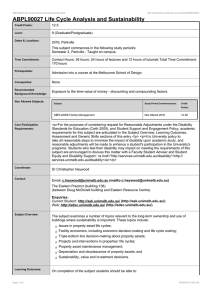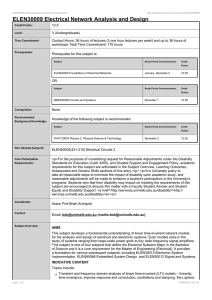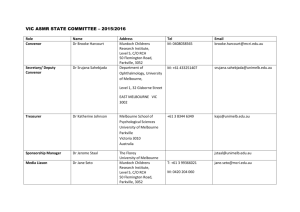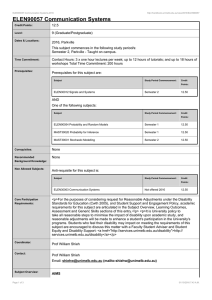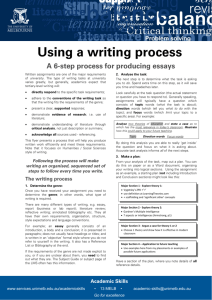ENVS20001 Digital Design and Fabrication
advertisement
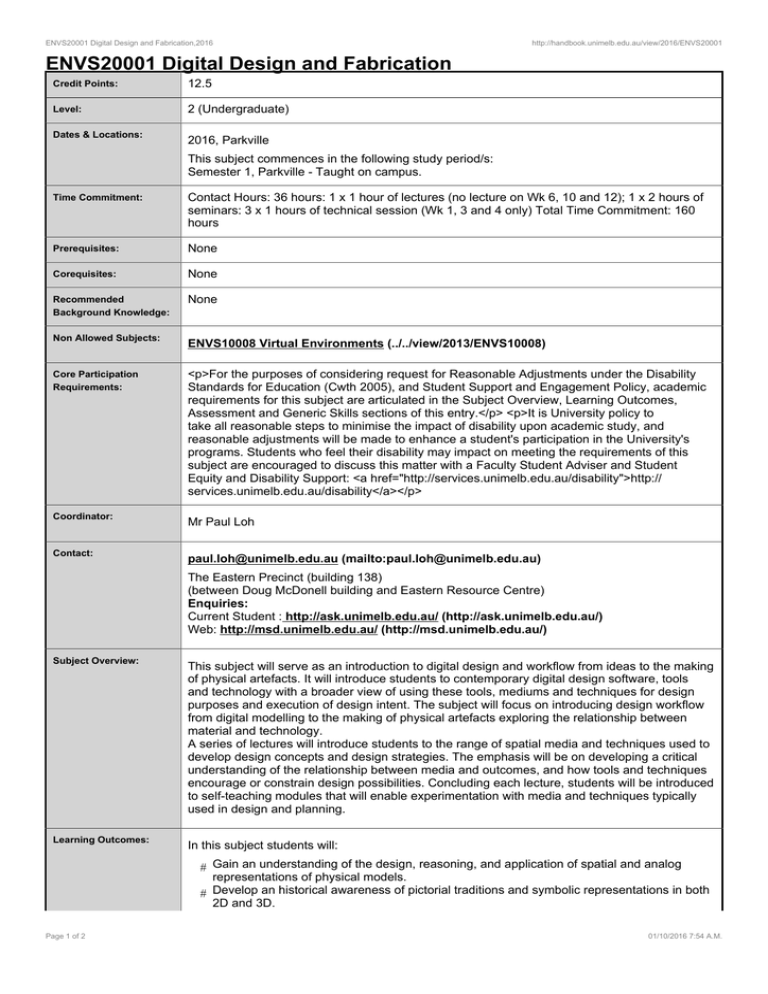
ENVS20001 Digital Design and Fabrication,2016 http://handbook.unimelb.edu.au/view/2016/ENVS20001 ENVS20001 Digital Design and Fabrication Credit Points: 12.5 Level: 2 (Undergraduate) Dates & Locations: 2016, Parkville This subject commences in the following study period/s: Semester 1, Parkville - Taught on campus. Time Commitment: Contact Hours: 36 hours: 1 x 1 hour of lectures (no lecture on Wk 6, 10 and 12); 1 x 2 hours of seminars: 3 x 1 hours of technical session (Wk 1, 3 and 4 only) Total Time Commitment: 160 hours Prerequisites: None Corequisites: None Recommended Background Knowledge: None Non Allowed Subjects: Core Participation Requirements: Coordinator: Contact: ENVS10008 Virtual Environments (../../view/2013/ENVS10008) <p>For the purposes of considering request for Reasonable Adjustments under the Disability Standards for Education (Cwth 2005), and Student Support and Engagement Policy, academic requirements for this subject are articulated in the Subject Overview, Learning Outcomes, Assessment and Generic Skills sections of this entry.</p> <p>It is University policy to take all reasonable steps to minimise the impact of disability upon academic study, and reasonable adjustments will be made to enhance a student's participation in the University's programs. Students who feel their disability may impact on meeting the requirements of this subject are encouraged to discuss this matter with a Faculty Student Adviser and Student Equity and Disability Support: <a href="http://services.unimelb.edu.au/disability">http:// services.unimelb.edu.au/disability</a></p> Mr Paul Loh paul.loh@unimelb.edu.au (mailto:paul.loh@unimelb.edu.au) The Eastern Precinct (building 138) (between Doug McDonell building and Eastern Resource Centre) Enquiries: Current Student : http://ask.unimelb.edu.au/ (http://ask.unimelb.edu.au/) Web: http://msd.unimelb.edu.au/ (http://msd.unimelb.edu.au/) Subject Overview: Learning Outcomes: This subject will serve as an introduction to digital design and workflow from ideas to the making of physical artefacts. It will introduce students to contemporary digital design software, tools and technology with a broader view of using these tools, mediums and techniques for design purposes and execution of design intent. The subject will focus on introducing design workflow from digital modelling to the making of physical artefacts exploring the relationship between material and technology. A series of lectures will introduce students to the range of spatial media and techniques used to develop design concepts and design strategies. The emphasis will be on developing a critical understanding of the relationship between media and outcomes, and how tools and techniques encourage or constrain design possibilities. Concluding each lecture, students will be introduced to self-teaching modules that will enable experimentation with media and techniques typically used in design and planning. In this subject students will: # Gain an understanding of the design, reasoning, and application of spatial and analog representations of physical models. # Develop an historical awareness of pictorial traditions and symbolic representations in both 2D and 3D. Page 1 of 2 01/10/2016 7:54 A.M. ENVS20001 Digital Design and Fabrication,2016 http://handbook.unimelb.edu.au/view/2016/ENVS20001 # Understand object-centred representations from aerial, topographic, planar and volumetric perspectives. # Understand process-centred representations through digital, distributed/networked, timebased, quantitative, and kinetic/performative/responsive applications. # Develop ways of reading and interpreting such representations with a cultural and critical lens. Assessment: Analogue/digital drawing and modelling formatted as journal document with oral presentation (equivalent to 1600 words), two submissions (week 4 and mid-semester), 40%; Final design project using mixed media, supporting drawings and analysis with oral presentation (equivalent to 1200 words), end of semester (before examination period), 30%; Critical review of lectures and design project (1200 words), end of semester (first week of examination period), 30%. Prescribed Texts: Rhinoceros software. Note: Apple-Mac users will require Windows operating system. Breadth Options: This subject potentially can be taken as a breadth subject component for the following courses: # Bachelor of Arts (https://handbook.unimelb.edu.au/view/2016/B-ARTS) # Bachelor of Biomedicine (https://handbook.unimelb.edu.au/view/2016/B-BMED) # Bachelor of Commerce (https://handbook.unimelb.edu.au/view/2016/B-COM) # Bachelor of Music (https://handbook.unimelb.edu.au/view/2016/B-MUS) # Bachelor of Science (https://handbook.unimelb.edu.au/view/2016/B-SCI) # Bachelor of Engineering (https://handbook.unimelb.edu.au/view/2016/B-ENG) You should visit learn more about breadth subjects (http://breadth.unimelb.edu.au/ breadth/info/index.html) and read the breadth requirements for your degree, and should discuss your choice with your student adviser, before deciding on your subjects. Fees Information: Subject EFTSL, Level, Discipline & Census Date, http://enrolment.unimelb.edu.au/fees Links to further information: http://edsc.unimelb.edu.au/ Related Majors/Minors/ Specialisations: Environments Discipline subjects Page 2 of 2 01/10/2016 7:54 A.M.
